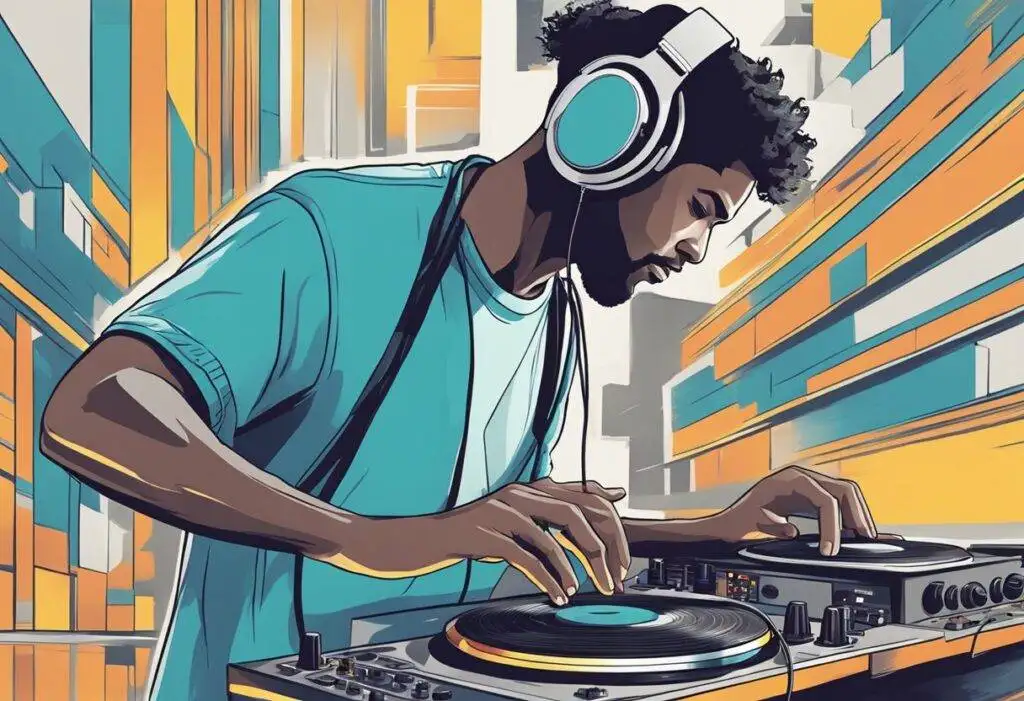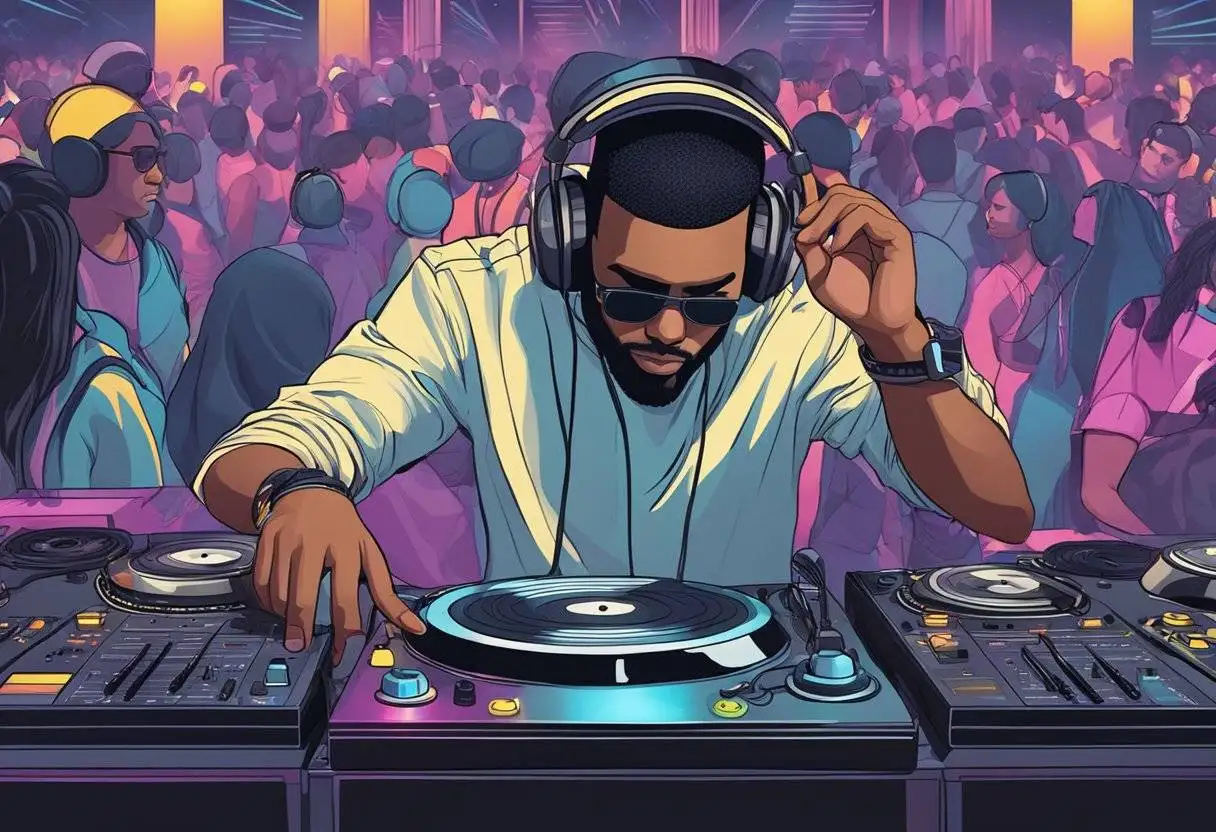I often see people intrigued by the sight of a DJ bobbing their head to the music with headphones that seem to come on and off with almost ritualistic regularity. This action is not just for show; there’s a crucial functional reason behind it. As a DJ myself, I can attest that managing the auditory environment is essential for seamless transitions and engaging sets. Essentially, headphones are the conduit for what we call ‘pre-cueing,’ enabling us to hear the next track before the audience does.

The motion of putting headphones on and off allows me to make sure that what is about to be played matches perfectly with what the audience is currently enjoying. The act serves multiple purposes: from beatmatching two tracks to cueing the perfect entry point of the next song. It’s all about synchronization and ensuring that the energy on the dance floor never wanes. Without the aid of headphones, I would be flying blind, unable to prepare and execute the precise mix that the crowd expects and deserves.
Key Takeaways
- DJs use headphones to preview and prepare the next track for a seamless mix.
- The process of beatmatching and cueing is vital for maintaining the flow of a DJ set.
- Interaction with the audience is enhanced by the careful control of audio transitions.
Understanding DJ Headphones

When I approach the decks, my headphones are an extension of my senses, critical to blending tracks seamlessly. They serve as my control room, offering audio quality that helps me align the grooves to the expectations of the audience. Let’s dive into the intricacies of these vital tools in my DJ arsenal.
Purpose of Headphones in DJing
The primary role of my headphones is cueing. I rely on them to preview and cue the next track, making sure it’s lined up perfectly with the current beat. This process requires listening to the upcoming track in isolation, often while the main audio is being blasted through the speakers to the crowd. Headphones offer me a glimpse into the future of the mix without revealing it to the audience.
Additionally, headphones are critical for beatmatching, which is synchronizing the tempo of two tracks. I adjust the pitch and tempo, often tweaking the gain and volume levels for a proper mix. With the ability of most DJ headphones to switch between stereo and mono modes, I can monitor frequencies more accurately and decide when to engage either the line fader or crossfader.
Headphone Features for DJs
Audio quality is paramount, and high-quality headphones deliver clarity across all frequencies. Critical features like noise-canceling and sound quality enable me to concentrate on mixing, ignoring the distractions of a noisy environment. Headphone controls allow quick adjustments to the volume or gain levels directly from the ear cups, ensuring that the audio I hear matches the master signal.
My headphones should be durable enough to withstand the rigors of frequent use and travel. I’ll often opt for models that offer noise isolation and robust construction, as they need to survive the knocks and drops of a DJ’s lifestyle.
Types of Headphones and Fit
Headphones come in various forms: over-ear, on-ear, ear cups, and the discreet in-ear monitors (IEMs). The choice depends on personal preference and the type of fit I need to remain comfortable throughout my set. Having wireless headphones offers me mobility, but they must maintain reliable audio connection to avoid dropouts.
For traditionalists, over-ear headphones with swiveling ear cups provide excellent audio quality and isolation, whilst in-ear monitors provide a direct, secure fit, with the advantage of being lightweight and inconspicuous.
Adjusting Sound Levels
Fine-tuning sound levels is crucial for a smooth transition between tracks. I often use the split cue function, which allows me to hear the cued track in one ear and the main output in the other. This facilitates precise adjustments to the level and gain of the cued track until it matches the live one.
The mono split feature of my headphones gives me an alternative way to listen to both the cued and master signals simultaneously in one ear, offering me another method to manage and blend tracks with precision.
The Art of Mixing and Cueing
When I DJ, I rely heavily on my ability to mix and cue tracks seamlessly, this involves precise beatmatching, managing transition and timing, and effective use of mixer controls.
Beatmatching Techniques
The foundation of my DJ sets lies in beatmatching, where I synchronize the tempo of two tracks. I use my headphones to listen to the track I’m about to play and align its beats with the one currently playing. This involves adjusting the pitch fader to alter the BPM (beats per minute) until the beats lock in sync. Successful beatmatching creates a continuous rhythm that keeps the dance floor moving without interruption.
Transition and Timing
A smooth transition is key to maintaining the energy on the dance floor. I carefully time the introduction of the new track, often starting with quieter elements before bringing in the full beat. By keeping an ear on my headphones and the other on the speakers, I determine the optimal point for the transition. The timing of when to transition depends on the cueing of the incoming track, ensuring it matches the energy and flow of the live set.
Using Mixer Controls
The mixer is my instrument for controlling how songs blend during a set. Each channel has a gain control to adjust levels, ensuring neither track overpowers the other. I use the line fader to introduce the new song and the crossfader to smoothly shift the audience’s attention between tracks. Manipulating these controls allows me to take my audience on a journey, crafting a unique playlist by blending songs with precision.
Interacting with the Audience

When I’m performing, my interaction with the audience is crucial. It’s about more than just playing tracks—it’s an art of engagement and creating a vibe that resonates with the crowd. My actions, including putting headphones on and off, play a part in this dynamic exchange.
Audience Engagement
I make it a point to be attuned to the crowd’s reactions. Audience engagement is key; it’s a real-time feedback loop. When I put on my headphones, I’m searching for the next track that will keep the energy high or change it as needed. Taking them off is a signal that I’m ready to drop the beat, and it also gives me an opportunity to make eye contact and connect with the people. These actions are silent forms of communication and tell the audience I’m in control and ready for what’s next.
Creating the Right Atmosphere
Atmosphere is everything. Whether it’s a high-energy club or a more intimate venue, the vibe depends on the synchronization between the music, the people, and, of course, myself. Adjusting the audio coming through my speakers and monitors with the help of my headphones allows me to enhance the live set experience. I must gauge the crowd’s mood and harness it, using my gear to transition smoothly between tracks and keeping the energy flow seamless.
DJ Equipment and Venue Settings
Each venue has its unique acoustics and equipment, which means I have to adapt my setup, whether it’s the mixer, turnables, or the location of the speakers. When I put my headphones on, it might be to check the mixing levels privately, so the next track matches the current one playing through the speakers without the audience noticing the behind-the-scenes work. Understanding and adjusting to the technical aspects of my gear and the venue settings is vital to ensure the music experience is top-notch for everyone involved.
Frequently Asked Questions

In this section, I’ll address some common inquiries about the practices of DJs with their headphones. These questions focus on the reasons and methods behind how and why DJs manipulate their headphones during live performances.
What is the purpose behind DJs wearing headphones while performing?
DJs wear headphones to precisely cue and preview tracks, allowing them to synchronize the upcoming track with the one currently playing for a seamless transition. This process requires careful listening that’s not possible through the main speakers.
How does wearing headphones assist DJs in mixing tracks?
Headphones provide DJs with a direct audio feed to sync tempo and beats, ensuring two tracks can merge without noticeable disruption. They help isolate the next track, making beatmatching and timing adjustments easier before going live.
For what reasons might a DJ choose to wear headphones around their neck rather than on their ears?
Wearing headphones around the neck allows DJs quick access to them when needed while they might temporarily listen to the main mix through the speakers, interact with the crowd, or manage other aspects of their performance setup without interference.
In what scenarios would a DJ deliberately not use headphones during a set?
A DJ may forgo headphones when performing a pre-planned set with little need for beatmatching or when using software that visually assists in syncing tracks. Also, in some casual settings, a DJ might rely on their knowledge of the tracks and the speakers’ output.
Why do some DJs only listen through one earcup while DJing?
Some DJs listen through one earcup to compare the cued track in one ear with the live mix in the other. This technique allows them to maintain awareness of both the crowd’s audio and the upcoming track simultaneously for better control over blending songs.
What is the significance of DJs adjusting knobs frequently during their performances?
Adjusting knobs during a performance is essential for fine-tuning the sound output. This correlates to the EQ levels, effects modulation, and volume control to optimize the sound quality in real-time and ensure that each track is presented at its best.
